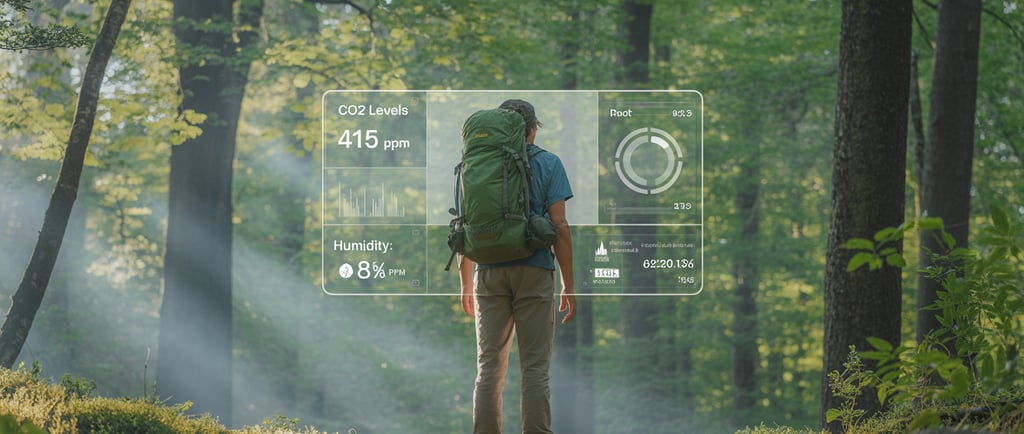When the Algorithm Stops Predicting and Starts Understanding
Can technology do more than predict? In a world facing environmental and cultural tipping points, this article explores how artificial intelligence when guided by creativity and ethics can help us truly understand and regenerate the places we travel to. A vision for the future of tourism, where every journey becomes a meaningful act of restoration.
Frederic Kauffmann
5/8/20253 min read


For a long time, we believed that traveling was simply about moving to discover. But today, in the midst of an unprecedented environmental and cultural crisis, we realize that every journey also transforms the place we touch. The question is no longer whether we travel, but how we do it. Can the act of traveling become a regenerative contribution?
Sustainability has guided our decisions for years. It has been a sincere attempt to mitigate impact, to balance our footprint. But in this May of 2025, with ecosystems under stress and local communities calling for a different kind of relationship with visitors, we must ask: is "doing no harm" enough? My conviction is that it is not. We need to go further to imagine a form of tourism that not only respects but also repairs. That does not merely observe, but contributes. A tourism that regenerates.
This raises a fundamental question: how do we make this happen? How do we reimagine the way we travel with the tools of today? I believe the answer lies in the alliance between human creativity and artificial intelligence. If we want to design tourism that brings real value to territories, we must combine sensitivity and intuition with the analytical depth and synthesis that technology can offer.
When we talk about AI, we often think of algorithms that predict behaviors, anticipate decisions, and optimize processes. But the shift we need isn’t just about prediction. We need technologies that help us understand places, their fragility, their rhythms, their communities. It’s not about guessing the future, but interpreting the present in depth.
I imagine an AI that does not act as a cold algorithm, but as a sensitive sensor of a territory’s pulse. Capable of reading ecological patterns, detecting vulnerabilities in soil or water, interpreting cultural and social dynamics, and translating all that into actionable and meaningful information. But even the most precise reading needs human judgment to become strategy. AI can help us listen to a place, but we are the ones who decide how to respond.
This collaboration between humans and machines can open up a new horizon of experiences. Imagine itineraries where the traveler is not just a spectator but a participant: in restoring ecosystems, recovering traditional agricultural techniques, transmitting oral histories at risk of disappearing. AI can help identify the critical points of a destination and connect with the right local actors. But creativity will define how to do it respectfully, educationally, and transformatively.
True change happens when we stop designing trips only for the traveler and begin designing them with and for the place being visited. Regeneration must originate from within communities. It cannot be imposed from the outside. Here, digital platforms and emerging technologies can democratize access to tools so that the people of the territory artisans, farmers, local guides can also become narrators of their own stories. They must lead the narrative, and tourism must contribute to their well-being, not deplete them.
To scale this vision, we need stories that inspire. Narratives that go beyond complaint to show what is possible. Creativity, amplified by AI analysis, can help us understand which messages resonate, through which channels, and with what tone. And above all, it can help us tell real stories of destinations already on the path to regeneration. These stories have the power to mobilize an entire industry.
Still, we must be clear: technology does not guarantee positive impact. The temptation of greenwashing using regenerative labels without real transformation is real. That’s why the use of AI and any innovation must be guided by a strong ethical foundation. We need empathy, critical thinking, and long-term vision more than ever. Human values that no machine can replace (for now).
I envision a future where every journey leaves a positive legacy. Where ecosystems benefit from the traveler’s presence, where local communities grow in self-esteem and well-being, and where travel becomes a commitment to the world. A future where creativity and artificial intelligence work together to make tourism one of the most powerful levers for planetary regeneration.
The challenge is clear. This is an invitation to all of us working in creativity, innovation, strategy, and tourism. It’s time to design and to live this new era. An era in which every step we take in the world leaves a fertile trace.
